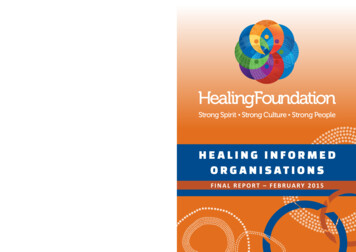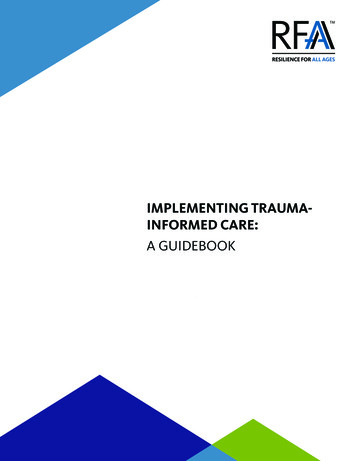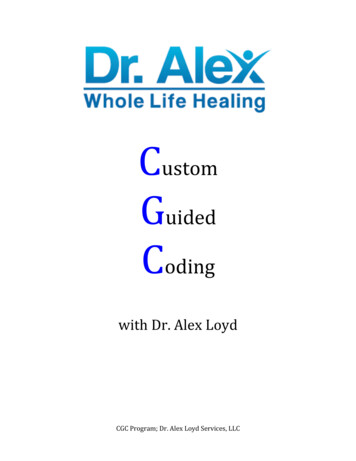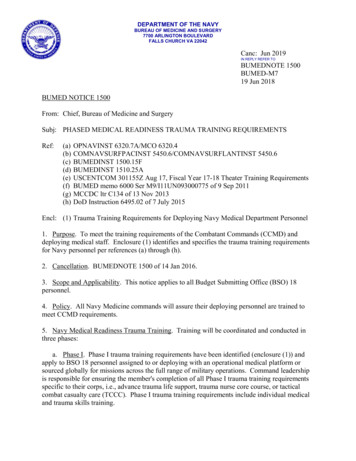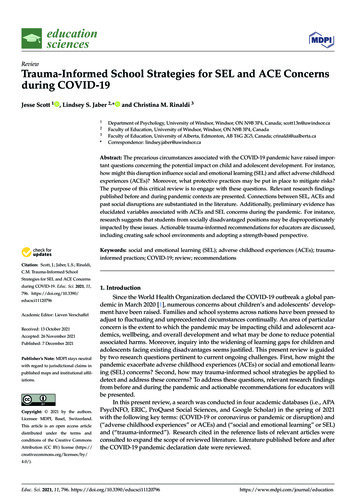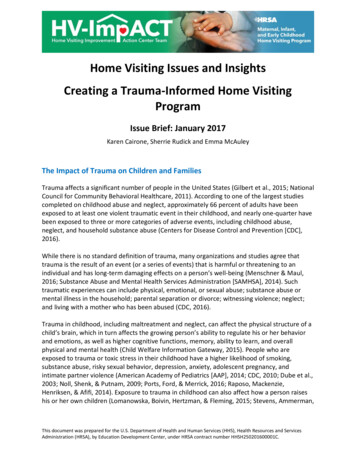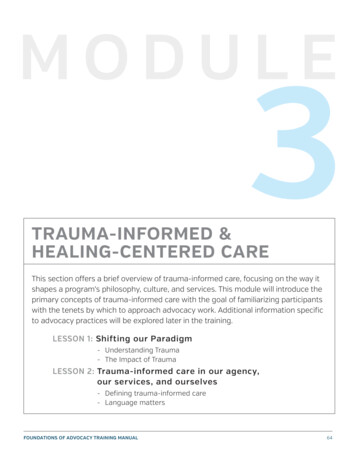
Transcription
MODULE 3:TRAUMA-INFORMED &HEALING-CENTERED CAREThis section offers a brief overview of trauma-informed care, focusing on the way itshapes a program’s philosophy, culture, and services. This module will introduce theprimary concepts of trauma-informed care with the goal of familiarizing participantswith the tenets by which to approach advocacy work. Additional information specificto advocacy practices will be explored later in the training.LESSON 1: Shifting our Paradigm- Understanding Trauma- The Impact of TraumaLESSON 2: T rauma-informed care in our agency,our services, and ourselves- Defining trauma-informed care- Language mattersFOUNDATIONS OF ADVOCACY TRAINING MANUAL64
MODULE 3: TRAUMA-INFORMED & HEALING-CENTERED CAREOBJECTIVESParticipants will be able to: Describe what is meant by “trauma.” Define trauma-informed and healing-centered care. Discuss the five guiding principles of trauma-informed care. Describe trauma-informed and healing-centered care’s impact on survivorsof sexual violence.MATERIALS Training agenda (if you create one) Flipchart paper or dry erase board and markers Pens/pencils and paper for each trainee Tape Copies of your organizational statements and policies related totrauma-informed care Copies of “Understanding Trauma: Factors that Influence Trauma” handout (atend of this module) Copies of Building Cultures of Care: A Guide for Sexual Assault ServicesPrograms (available online at publications nsvrc building-cultures-of-care.pdf) Copies of SADI Trauma-Informed Care handout (at end of this module) Trauma-Informed Care Activity Cards (at end of this module) Computer with screen, projector, internet, and audioFOUNDATIONS OF ADVOCACY TRAINING MANUAL65
MODULE 3: TRAUMA-INFORMED & HEALING-CENTERED CARETIPS FOR PREPARATION A short TED Talk is recommended for viewing during part one of this session.Set up technology in advance and test out the clip to make sure it runssmoothly. This film is about 15 minutes long and requires video and audio.How Childhood Trauma AffectsHealth Across the Lifetimeby Nadine Burke Harrishttps://www.ted.com/talks/nadine burke harris howchildhood trauma affectshealth across a lifetime/discussion?language en#t-671093 Print or otherwise obtain the articles and handouts listed in the Materialssection of this module and make copies for participants. Review articles, materials, and lessons to be comfortable with the materialbefore the training session.FOUNDATIONS OF ADVOCACY TRAINING MANUAL66
MODULE 3: TRAUMA-INFORMED & HEALING-CENTERED CAREPOINTS TO CONSIDER Don’t be afraid to discuss your program’s paradigm shift to traumainformed and healing-centered care.For some advocacy programs, an approach that is trauma-informed andhealing-centered may be new in concept or practice. For others, it may bean approach that has been central to the agency for some time. Trainersshould not hesitate to talk about the evolution of a program’s philosophy andgrowth in their work with survivors. Discussing this shift in paradigm and theprogram’s commitment to growing to better support survivors demonstratesa culture of learning and one that is not afraid of change or growth tobenefit survivors. Our words matter.Key to a trauma-informed approach to advocacy is shifting away fromthe dominant narrative of “What’s wrong with you?” to instead center thequestion of “What happened to you?” Language is powerful and can reflectdeep intention and understanding. Questions that are deficit-based or thatsuggest blame are harmful to survivors and do not reflect a trauma-informedapproach. When we ask better questions that reflect an understanding ofthe impact of trauma and honor that survivors are doing the best they cangiven what they are experiencing, we embody the principles of traumainformed care. Critical to this shift in paradigm is that advocates practiceawareness that their work is always to meet survivors where they are at andbe open to whatever survivors do (or do not) want to share. Advocating froma place of seeing survivors as whole people who are dealing with traumadoes not require asking for an account of traumatic experiences, but doesmake space for a survivor to share whatever feels helpful. A trauma-informedapproach centers the survivor and their self-identified needs to informsupport and resources. Trauma-informed care is the foundation for advocacy work.Trauma-informed care will be an underlying framework throughoutthe training manual. This section helps build a critical foundation forunderstanding advocacy work. By first understanding the impact of trauma,we can understand what it means for how support and resources are madeavailable to survivors. The tenets of this section should be referred back to,as relevant, to make connections with information learned in future modules.FOUNDATIONS OF ADVOCACY TRAINING MANUAL67
MODULE 3: TRAUMA-INFORMED & HEALING-CENTERED CARELESSON 1: SHIFTING THE PARADIGMUNDERSTANDING TRAUMADuring this session, trainer/s will provide foundational information on trauma-informedcare for participants to build a strong base for their advocacy work.Trainer/s should introduce the topic of trauma-informed care as the philosophy andapproach that guides the work of the agency. Some participants may be more or lessfamiliar with the concept. It can be introduced by first explaining what is meant whenwe discuss the word trauma. An explanation of trauma-informed care will follow inthe next lesson.GROUP BRAINSTORMInvite participants to respond to share aloud with the group what they think of whenthey hear the word “trauma.” Common examples might include: Pain Discrimination Something bad has happened Crying Physical injury/wound Hospital Car crash A near death experience Post Traumatic Stress Disorder An emergency Suffering War Hurt Past struggles Sexual violence Abuse A desperate need for help Loss of a loved one AbandonmentEncourage the group to reflect on the range of items they included on the list. Whatdo they notice?FOUNDATIONS OF ADVOCACY TRAINING MANUAL68
MODULE 3: TRAUMA-INFORMED & HEALING-CENTERED CARELECTUREThere are many definitions of “trauma.” Some rely on clinically grounded criteria, othersare more holistically based, and many exist in between.For the purposes of our work in advocacy, we consider two primary and overlappingdefinitions of trauma: Trauma is an experience or experiences that cause overwhelming stress(Substance Abuse and Mental Health Services Administration [SAMHSA], 2014). Trauma is what happens inside of you as a result of traumatic events. It is a loss ofconnection to oneself and the present moment (Kiloby, 2017).Traumatic events, such as sexual violence, abuse, neglect, and other forms of violenceor harm can be causal factors of trauma. Trauma is the way we experience an event orevents, physically, emotionally, spiritually, and relationally.Critical to understanding trauma is knowing that there isn’t one singular way that peoplewill experience something. A similar experience can happen to different people, andbased on a series of factors related to their lived context, they may experience the eventdifferently. This is normal — there is no “right” or “wrong” way to experience trauma.FOUNDATIONS OF ADVOCACY TRAINING MANUAL69
MODULE 3: TRAUMA-INFORMED & HEALING-CENTERED CARESMALL GROUP ACTIVITY: INSTRUCTIONSIn pairs, using the worksheet provided “Understanding Trauma: Factors that InfluenceTrauma,” participants can consider the different factors that might affect the way aperson experiences trauma. After pairs have had a chance to consider their responses,trainers can debrief the activity as a larger group using the facilitator’s handout.Themes of discussion: There are many factors related to how a person experiences trauma, some inplace prior to a person’s experience with sexual violence, others specific to theevent itself, as well as those related to their experience after sexual violence. Our identities and lived experiences intersect, making it essential that supportiveresources for survivors of sexual violence reflect a thorough understanding ofthe factors that influence trauma and what may or may not be helpful in one’shealing process. Future modules will provide additional opportunity to learn about how advocatesincorporate this understanding of trauma into advocacy practice. At this time it’smost important that we have awareness that survivors of sexual violence havemany different experiences and reactions in response to sexual violence, and thatthese are influenced by the factors we’ve discussed.FOUNDATIONS OF ADVOCACY TRAINING MANUAL70
MODULE 3: TRAUMA-INFORMED & HEALING-CENTERED CARETHE IMPACT OF TRAUMADiscussion of the impact of trauma will be woven throughout the duration of the training,but we must start by rooting ourselves in the magnitude of its impact and what thatmeans for the way we do advocacy work.Begin by showing “How Childhood Trauma Affects Health Across the Lifetime” How Childhood Trauma Affects Health Across the Lifetimeby Nadine Burke Harrishttps://www.ted.com/talks/nadine burke harris howchildhood trauma affects health across a lifetime/discussion?language en#t-671093GROUP DISCUSSIONAsk the participants to discuss: What were the themes of the video? How does this shape the way you influence the impact of trauma? The speaker’s main focus is traumatic stress rooted in adverse childhoodexperiences. In the context of our work, we know that people of all agesexperience adverse experiences, including sexual violence. How do you thinkNadine Burke Harris’ message influences advocacy work with survivors of all ages? What are you taking from the TED Talk?FOUNDATIONS OF ADVOCACY TRAINING MANUAL71
MODULE 3: TRAUMA-INFORMED & HEALING-CENTERED CAREThemes of Clip:Share the following points to wrap up the discussion. Research shows that early experiences of trauma, especially in high quantity, havea strong connection to challenges later in life, specifically negative physical andmental outcomes Helping professions have the ability to provide much needed support andresources to help lessen negative consequences of trauma A holistic approach to understanding wellness is one that recognizes that mentaland physical health overlap; these aren’t issues that can be compartmentalized Many of us are impacted by trauma, across community, socioeconomic status,geographic location, etc., including those in helping professions Those in helping professions have a responsibility to build systems and servicesthat acknowledge trauma and help to lessen its impactFOUNDATIONS OF ADVOCACY TRAINING MANUAL72
MODULE 3: TRAUMA-INFORMED & HEALING-CENTERED CARELESSON 2: TRAUMA-INFORMED CARE IN OURAGENCY, OUR SERVICES, AND OURSELVESTIPS FOR PREPARATION Print or otherwise obtain the articles and handouts listed in the Materialssection of this module and make copies for participants. Review articles, materials, and lessons to be comfortable with the materialbefore the training session.DEFINING TRAUMA-INFORMED CARELECTURETrauma influences how people approach and respond to services, making it essentialthat organizations serving survivors of sexual assault recognize expressions of traumaand acknowledge the role trauma plays in people’s lives. This enables organizations tobetter understand and address the needs of individuals who have experienced sexualviolence (Proffitt, 2010). The goal of this approach, known as “trauma-informed care,” isto support the healing and growth of survivors while avoiding retraumatization. Traumainformed care is a philosophy and a skill set. Its underlying philosophy is grounded ingrassroots and survivor-centered models that came from the early rape crisis centerand domestic violence movements. Its evolution has made it an approach recognizedin many mental health, medical, and advocacy models and settings. It provides aframework for understanding the impact of trauma on survivors, communities, and thosethat serve them. It also is a reference point for building strong organizations and sexualassault services that are responsive to those needs (Resource Sharing Project [RSP] &National Sexual Violence Resource Center [NSVRC], 2017).This approach is multidimensional and can be seen throughout the various spheres of anorganization, including: organizational culture, services provided, and the individual staff,volunteer, and intern commitment to self-care and growth.FOUNDATIONS OF ADVOCACY TRAINING MANUAL73
MODULE 3: TRAUMA-INFORMED & HEALING-CENTERED CAREUsing the “Trauma-Informed Care” handout (adapted from: Building Cultures of Care (RSP& NSVRC, 2017), explain the six main components of trauma-informed care. These are: SafetyThroughout the organization, the staff and the people they serve, whetherchildren or adults, feel physically and psychologically safe; the physicalsetting is safe and interpersonal interactions promote a sense of safety.Understanding safety as defined by those served is a high priority. Cultural relevanceThe organization actively values and works to connect survivors with culturallyrelevant support, including, for mainstream programs, referrals to culturallyspecific organizations and services. The organization also incorporatespolicies, protocols, and processes that are responsive to the racial, ethnic,and cultural needs of the survivors served, and recognizes and addresseshistorical trauma. Similarly, the organization’s internal policies, protocols, andprocesses for staff reflect cultural awareness and a commitment to equity. TrustworthinessDecisions are transparent and people and relationships are prioritized.Building and maintaining trust with survivors, staff, and others involved in theorganization is core to the organization’s work. ChoiceOrganizations understand power differentials and the ways in which survivorshave historically had voice and choice taken away from them. Survivors aresupported in the decisions they make and what they identify as needed to helpthem heal. Staff are also supported to make decisions in how they do their work. CollaborationImportance is placed on leveling power differences to meaningfully sharepower and decision-making, both in advocacy work with survivors and acrossall levels of an organization. EmpowermentAdvocacy staff and other potential service providers are viewed as potentialhelpers along a survivor’s healing journey, but not in control of healing.Survivors are encouraged to practice awareness of their strengths and settheir own goals for what feels empowering as they heal.FOUNDATIONS OF ADVOCACY TRAINING MANUAL74
MODULE 3: TRAUMA-INFORMED & HEALING-CENTERED CAREGROUP ACTIVITYPlace the six category cards (Safety, Cultural Relevance, Choice, Collaboration, Trust,and Empowerment) on the wall or board, with space underneath each category that willeventually be filled in by participants’ example cards. Using the example cards provided,equally divide cards among participants. Ask participants to read through the exampleson their cards and consider the category that the card fits under. After participantshave had time to review their cards, instruct participants to place the cards under thecategory they believe is the best fit.Debrief the activity. What do you notice about the examples? Was there anything you were surprised to see? Or need more explanation about? What themes do you notice? Do you notice overlap with any of the examples and categories?Themes Trauma-informed care is present throughout an organization. It’s both philosophy and practice. These are concrete ways that organizations,services, and staff, volunteers, and interns embody trauma-informed care. A trauma-informed practice values survivors as their specific needs; there is no“one way” or “right way” Trauma-informed care prioritizes care for staff, volunteers, and interns as well ascare for survivorsFOUNDATIONS OF ADVOCACY TRAINING MANUAL75
MODULE 3: TRAUMA-INFORMED & HEALING-CENTERED CARELANGUAGE MATTERSLECTURELanguage is powerful in shaping how we see a topic. The philosophy behind our workshould always be easy to understand in our language, meaning: our words matter.How we talk about things should reflect the trauma-informed, survivor-centeredapproach to advocacy.We strive to use person-first language. This means we focus on the person rather than acharacteristic about them or an event that has happened to them.Examples of person-first language include: “Survivor of sexual violence” instead of “Sexual violence survivor” “He was hospitalized for mental care” instead of “He got 302’d” “A person who is struggling with an eating disorder” instead of“a bulimic” or “an anorexic” “A person who uses a wheelchair” instead of “Disabled”We also strive to use language that is empowering and survivor-centered when relayinginformation about survivors and their decisions.Examples of empowering and survivor-centered language include: “She chose not to do that” instead of “She was non-cooperative” “They are trying to decide what’s best for them” instead of “They are unwilling tomake a decision” “She is angry and upset that this process is taking so long” instead of“She is hostile and making this difficult” “He is not interested in sharing more at this time” instead of“He refuses to be forthcoming”FOUNDATIONS OF ADVOCACY TRAINING MANUAL76
MODULE 3: TRAUMA-INFORMED & HEALING-CENTERED CAREGROUP DISCUSSION What differences do you notice in the language used? Why does it matter? How does person-first language relate to trauma-informed andhealing-centered care? Are there other examples you can think of? If your own life or in this work?ReferencesKiloby, S. (2017, September 8). Gabor Maté trauma and loss of connection to oneself [Video]. YouTube.https://www.youtube.com/watch?v 78NAEGycyQsResource Sharing Project, & National Sexual Violence Resource Center. (2017). Building cultures of care:A guide for sexual assault services programs. ult-services-programsSubstance Abuse and Mental Health Services Administration. (2014). Concept of trauma and guidance for atrauma-informed approach (HHS Publication No.(SMA) 14–488). iv/sma14-4884.pdfFOUNDATIONS OF ADVOCACY TRAINING MANUAL77
MODULE 3: TRAUMA-INFORMED & HEALING-CENTERED CAREBUILDING A CULTURE OF CARE:CATEGORY CARDSSAFETYCULTURAL RELEVANCECategory Cards: pg. 1 of 3FOUNDATIONS OF ADVOCACY TRAINING MANUAL78
MODULE 3: TRAUMA-INFORMED & HEALING-CENTERED CAREBUILDING A CULTURE OF CARE:CATEGORY CARDSTRUSTWORTHINESSCHOICECategory Cards: pg. 2 of 3FOUNDATIONS OF ADVOCACY TRAINING MANUAL79
MODULE 3: TRAUMA-INFORMED & HEALING-CENTERED CAREBUILDING A CULTURE OF CARE:CATEGORY CARDSCOLLABORATIONEMPOWERMENTCategory Cards: pg. 3 of 3FOUNDATIONS OF ADVOCACY TRAINING MANUAL80
MODULE 3: TRAUMA-INFORMED & HEALING-CENTERED CAREBUILDING A CULTURE OF CARE:EXAMPLE CARDSAdvocates are consistentin how they respondand follow through withsurvivors.Advocates listen tosurvivor’s self-identifiedneeds and respondaccordingly.Advocates meet survivorswhere they are at.Staff is provided flexibilityto do their workOrganizational leadershipand staff practicedirect and ethicalcommunication.Organizational orprogrammatic challengesare discussed andmanaged, not swept underthe rug.Advocates share withsurvivors the values ofthe organization and theirrights as someone seekingsupport.The advocacy programinvolves staff in developingorganizational values.Survivors and staff areinformed of grievanceprocedures, should theyhave an issue and like toseek remedy.Advocates supportsurvivors in sharing aboutthe circumstances in whichthey are most comfortablemeeting.Advocates listen tosurvivors to understandwhat makes them feel safeor unsafe.Advocates offer empathyand work to create spacefor survivors to feel heardand respected.Advocacy programdemonstrates careand respect for staff byinvolving staff in policy andprotocol development as itpertains to their work.Advocacy programregularly discussesvicarious trauma andburnout with staff andhas practices in place tosupport staff wellbeing.Advocates work inpartnership with survivorsto meet their needs.Example Cards: pg. 1 of 3FOUNDATIONS OF ADVOCACY TRAINING MANUAL81
MODULE 3: TRAUMA-INFORMED & HEALING-CENTERED CAREBUILDING A CULTURE OF CARE:EXAMPLE CARDSAdvocates ask open-endedquestions to learn whatsurvivors find helpful.Advocates work withother partner agencies,as relevant, to coordinatesupport for survivors.Advocates areknowledgeable about otherservices and supports forsurvivors and refer andconnect to provide the bestcare possible to survivors.Advocacy programs workwith the community tocreate services reflectiveof each community’sneeds.Advocacy programselicit feedback fromstaff to inform how theorganization does its work.Advocacy programs areactive in the community,supporting intersectingcauses and missions.Services are tailored tomeet each person’s uniqueneeds.Staff is reflective of thecommunity it serves.Services are available inmultiple languages.Advocates supportculturally rooted healingpractices.Advocates practiceawareness of andchallenge their own biases.Advocates do not pushtheir beliefs on survivors.Advocacy programshave close partnershipswith culturally specificprograms and partners.Staff are supported inbringing their whole selvesto work (all identities,experience, and wisdom).Advocacy programsprovide regular learningopportunities to expandstaff knowledge andcapacity to providerelevant support to a widediversity of survivors.Example Cards: pg. 2 of 3FOUNDATIONS OF ADVOCACY TRAINING MANUAL82
MODULE 3: TRAUMA-INFORMED & HEALING-CENTERED CAREBUILDING A CULTURE OF CARE:EXAMPLE CARDSSurvivors are seen asthe experts of their ownexperiences and aresupported in making theirown decisions aboutwhat’s best for them.Survivors have variousoptions to choose from;advocacy programs arecomprehensive in serviceofferings in an effort tobe responsive to a widevariety of needs.Staff have flexibility withvarious aspects of theirwork and are able to makedecisions as it pertains totheir work.Survivors are never pushedto pursue one option oranother; they are providedwith information aboutoptions and encouragedregardless of what theydecide.Staff are supported inchoosing practices thatsupport their wellbeing,with knowledge that selfcare looks different foreveryone.Advocates work to helpsurvivors regain a sense oftheir own power.Healing is seen as a processthat takes time; advocatesrecognize that power wastaken from a survivor and itmay take time for survivorsto regain a sense of powerand strength.Survivors are supported inbeing a voice for change.Advocacy programssupport staff in makingdecisions about how theydo their work.Advocacy programsrecognize staff mayalso be survivors andwork to ensure they feelempowered in showing upas their full selves at work.Advocacy programsprovide staff opportunitiesfor continued learning andgrowth.Example Cards: pg. 3 of 3FOUNDATIONS OF ADVOCACY TRAINING MANUAL83
MODULE 3: TRAUMA-INFORMED & HEALING-CENTERED CAREBUILDING A CULTURE OF CARE:TRAINERS’ ACTIVITY KEYMany of the examples listed could fall under more than one category. There is oftenoverlap between the trauma-informed care components of trust, safety, collaboration,cultural relevance, choice, and empowerment.Trust Advocates are consistent in how they respond and follow throughwith survivors. Advocates listen to survivor’s self-identified needs and respond accordingly. Advocates meet survivors where they are at. Staff is provided flexibility to do their work Organizational leadership and staff practice direct andethical communication. Organizational or programmatic challenges are discussed and managed, notswept under the rug. Advocates share with survivors the values of the organization and their rightsas someone seeking support. The advocacy program involves staff in developing organizational values. Survivors and staff are informed of grievance procedures, should they havean issue and like to seek remedy.Safety Advocates support survivors in sharing about the circumstances in whichthey are most comfortable meeting. Advocates listen to survivors to understand what makes them feelsafe or unsafe. Advocates offer empathy and work to create space for survivors to feelheard and respected. Advocacy program demonstrates care and respect for staff by involving staffin policy and protocol development as it pertains to their work. Advocacy program regularly discusses vicarious trauma and burnout withstaff and has practices in place to support staff wellbeing.Trainers’ Activity Key: pg. 1 of 3FOUNDATIONS OF ADVOCACY TRAINING MANUAL84
MODULE 3: TRAUMA-INFORMED & HEALING-CENTERED CAREBUILDING A CULTURE OF CARE:TRAINERS’ ACTIVITY KEYCollaboration Advocates work in partnership with survivors to meet their needs. Advocates ask open-ended questions to learn what survivors find helpful. Advocates work with other partner agencies, as relevant, to coordinatesupport for survivors. Advocates are knowledgeable about other services and supports forsurvivors and refer and connect to provide the best care possible to survivors. Advocacy programs work with the community to create services reflective ofeach community’s needs. Advocacy programs elicit feedback from staff to inform how theorganization does its work. Advocacy programs are active in the community, supporting intersectingcauses and missions.Cultural Relevance Services are tailored to meet each person’s unique needs. Staff is reflective of the community it serves. Services are available in multiple languages. Advocates support culturally rooted healing practices. Advocates practice awareness of and challenge their own biases. Advocates do not push their beliefs on survivors. Advocacy programs have close partnerships with culturally specificprograms and partners. Staff are supported in bringing their whole selves to work (all identities,experience, and wisdom). Advocacy programs provide regular learning opportunities to expandstaff knowledge and capacity to provide relevant support to a widediversity of survivors.Trainers’ Activity Key: pg. 2 of 3FOUNDATIONS OF ADVOCACY TRAINING MANUAL85
MODULE 3: TRAUMA-INFORMED & HEALING-CENTERED CAREBUILDING A CULTURE OF CARE:TRAINERS’ ACTIVITY KEYChoice Survivors are seen as the experts of their own experiences and are supportedin making their own decisions about what’s best for them. Survivors have various options to choose from; advocacy programs arecomprehensive in service offerings in an effort to be responsive to a widevariety of needs. Staff have flexibility with various aspects of their work and are able to makedecisions as it pertains to their work. Survivors are never pushed to pursue one option or another; they areprovided with information about options and encouraged regardless ofwhat they decide. Staff are supported in choosing practices that support their wellbeing, withknowledge that self-care looks different for everyone.Empowerment Advocates work to help survivors regain a sense of their own power. Healing is seen as a process that takes time; advocates recognize that powerwas taken from a survivor and it may take time for survivors to regain a senseof power and strength. Survivors are supported in being a voice for change. Advocacy programs support staff in making decisions about howthey do their work. Advocacy programs recognize staff may also be survivors and work to ensurethey feel empowered in showing up as their full selves at work. Advocacy programs provide staff opportunities for continuedlearning and growth.Trainers’ Activity Key: pg. 3 of 3FOUNDATIONS OF ADVOCACY TRAINING MANUAL86
MODULE 3: TRAUMA-INFORMED & HEALING-CENTERED CARETRAUMA-INFORMED CAREThe key lessons from the Sexual Assault Demonstration Initiative are rooted in an understanding of traumainformed care. Trauma-informed care is a philosophy and a skill set. Its underlying philosophy is grounded ingrassroots and survivor-centered models that came from the early rape crisis center and domestic violencemovements. Programs using trauma-informed care are strengths-based, look at the effects from all formsof trauma, and are multi-dimensional in their approaches. Trauma-informed care provides a framework forunderstanding the impact of trauma on survivors, communities, and those who serve them and builds strongorganizations and sexual assault services that are responsive to those needs.Strengths-BasedRecognizes each person is the expert on their own experiences, with resilience as the core focusViews each person’s ways of coping and surviving with curiosity and awe rather than withjudgement or as symptoms or problems that need solvedSurvivor-CenteredUnderstands survivors within their family, social, and community contexts and life experiencesRespects each survivor as a whole person and recognizes the entire context of their livesIncludes addressing all forms of trauma past and present including racism, genocide, stateviolence, homophobia, and religious discriminationMulti-DimensionalIncludes six core elements: safety, trustworthiness, choice, collaboration, empowerment, andcultural relevanceThese core elements are applied throughout the three spheres of an organization: organizationalculture, services, and staffOrganizational cultureServicesStaff Actively addressing all formsof oppression Rooted in anti-oppressionand empowerment-basedframeworks Support for staff development Services made available acrossthe lifespan and throughout thehealing journey Empowering staff to makedecisions & be creative Mission statement Policies Values, beliefs, attitudes aboutsexual violence & healing Safety and comfort of offices& meeting spaces Accessible accommodatio
informed and healing-centered care. For some advocacy programs, an approach that is trauma-informed and healing-centered may be new in concept or practice . For others, it may be an approach that has been central to the agency for some time . Trainers should not hesitate to talk about the evolution of a program's philosophy and

